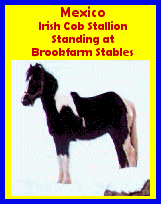 | Other Names: Gypsy Cob, Gypsy Shire, Gypsy Vanner Horse, Tinker Horse, Irish Cob, Irish Tinker, Gypsy Shire Origin: Mostly England and Ireland |
Color: Piebald (black and white) and skewbald (any other color and white) are the most common. However all colors are prized.
Avg Height: Cob- 14 to 15.2 hh / Vanner- 15.3 to 16 hh / Shire- 16 hh and over
Avg Weight: Varies by type.
Build: Colorful and compact, its short neck and back give the animal the power to pull the colorful caravans so loved by the Gypsy society. An abundance of mane, tail, and "feather" give this horse a magical look true to its heritage. Heavy bone, flat knees, and ample hooves give this magnificent animal the foundation to sustain a body that includes a broad chest and heavy hips. The withers are rounded making the horse very suitable for harness and the bareback riding style of the Gypsy children.
Temperament: A "kushti grai", the Gypsy expression for a favorable horse, should be able to work hard for many hours a day. It should have patience and, at the most, reliability. The Tinker Horses show quietness and harmony, regardless of their age or workout level. The Gypsy lifestyle can not tolerate animals that might endanger lives, and any horse displaying ill temper is banished immediately. The result of this culling has led to the Irish Tinker Horse being one of the most docile horses in the world. The intelligence and kindness that the Irish Tinker Horse exhibits must be experienced to be believed. The Irish Tinker is such a gentle horse that Gypsy mothers are known to tell their children to stop bothering the horses (as they crawl over and under them). A Tinker never becomes upset. Ultimately they are entrusted with pulling a Gypsy-caravan or "vardo", the mobile home, workshop and pride of the Gypsy-master. Nowadays one can still come across Tinker horses in the more quiet territories of England and Ireland, pulling the vardo.
Main use: Traditionally used to pull the colorful Gypsy wagons and carts.
Special abilities: A sound horse that is easily kept is essential for a lifestyle of travel . The Irish Tinker Horse, by nature of its evolvement, is extremely sound and easy to maintain. Jumping comes easily to Tinker Horses, and they ride well either Western or English style.
History: There are three different types of Tinkers based on size (in order from smallest to largest): the Gypsy Cob, the Gypsy Vanner, and the Gypsy Shire (similar to the British Drum Horse). The origin of the Tinker is rather complicated. They have the same name as the Irish Gypsies (Irish Travelers), earning their living as tinsmiths. The Irish Travelers were a very small minority group in Ireland. Until recently Irish Travelers were referred to as "Tinkers." This word, referring to their profession as tinsmiths and metalworkers, was derived from the Irish word "tinceard" (tinsmith). Nowadays this word is in general being used disparagingly. Gypsies have a saying, "My treasures do not chink or glitter... They gleam in the sun and neigh in the night." The love affair between Gypsies and their horses is legendary. A vision was born over half a century ago to create a very special horse - a magical looking horse - to pull the colorful caravans the Gypsy calls home. Until recently that vision was shared by few. The Irish Tinker Horse was developed from a combination of Shire, Clydesdale, Hunter, Irish Draught, Dales, Connemara pony and the descent probably contains more breeds. There's every reason to assume the Gypsies did buy up horses here and there, who didn't meet the requirements needed for the various breeds. For instance, a piebald Shire. It so happened that the Gypsies, while making their trips or at night, with or without the permission of the owners, took a stallion from a stable or a meadow and brought it up to the mares to serve. The breed didn't matter; only that it be for free. Which is why there is such variety in the Tinker Horse's background.
For Breeders, Farms, and Studs of this breed, click here.
If you have a horse of this breed, and you would like to see your pictures posted here, or if you would like to advertise your business that involves this particular breed, you can also email me.
I'm not perfect, and I never claim to be! If you see anything here that you believe I am wrong about, please feel free to email me. I might not agree with you, but at least I will listen!! :0) Can you fill in any of my blanks? Do you know of information or links that you would like to share with draft animal enthusiasts that you don't see here? Am I missing anything? Let me know at Draftladyb@yahoo.com.